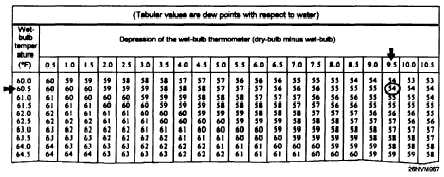| |
Temperature, Dew Point, and Relative Humidity, Continued
Electric
Psychrometer
The Electric Psychrometer ML-450/UM (fig. 10-13) is a hand-held
portable instrument that serves the same purpose as the sling
psychrometer. As a Quartermaster this will probably be the only type of
psychrometer that you use, since most ships do not carry the sling
psychrometer. Three D-size batteries furnish power to a self-contained
ventilation fan that aspirates the thermometer. The instrument also
contains a lamp for nighttime readings. When using the electric
psychrometer, select a shady area with no obstructions within 3 to 4 feet
and face into the wind. Hold the instrument at waist height with the air
intake pointing into the wind. Obtain the dry-bulb temperature first.
When the ambient (circulating) air temperature is 50°F, or above, it is
not necessary to energize the ventilation fan. The electric psychrometer
should be exposed to the ambient air for at least 5 minutes before you
read it. When no further decrease of the wet-bulb temperature is
apparent, read the wet-bulb.
Finding the Dew
Use the psychrometer table 10-2 to compute the dew point. The Manual
Point
for Ship's Surface Weather Observations (NAVOCEANCOMINST
3144.1C) contains complete tables. Take a dry-bulb temperature of 70°F
and a wet-bulb temperature of 60.5°F. The difference between the two
readings, 9.5°F, is called the wet-bulb depression.
Example: To compute the dew point, you enter the wet-bulb reading
(60.5°F). Go to the proper DEPRESSION column (9.5°F). Read the
dew point temperature (54°F) directly from the intersection of the
temperature row and the DEPRESSION column.
Table 10-2. Psychrometer Table
10-29
|

